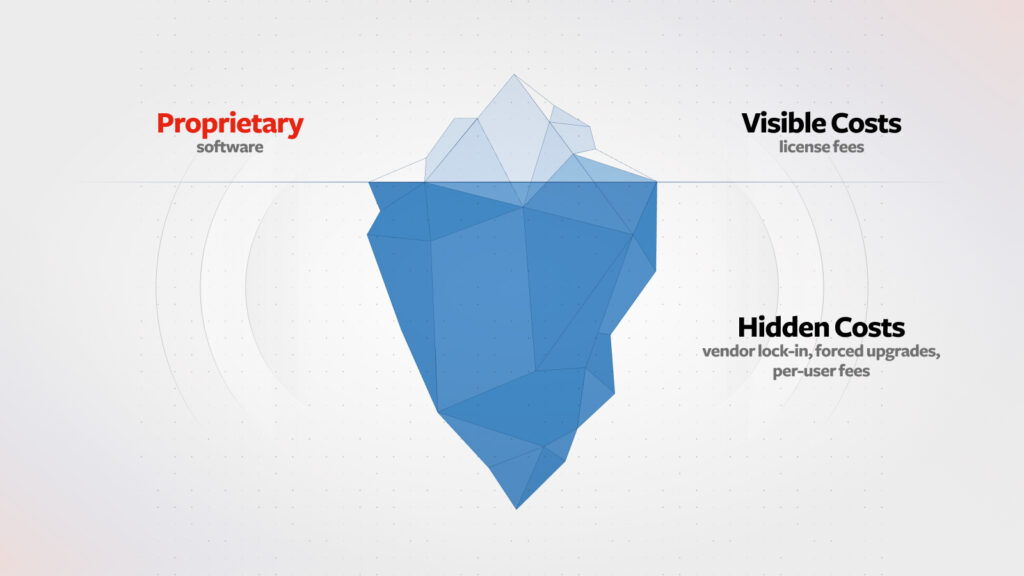- Open Source delivers cost efficiency, vendor independence, and scalable performance, but executives often hesitate due to concerns about security and complexity.
- Open Source, when properly planned and managed, can be more secure, offer significantly lower total cost of ownership, and be more adaptable than proprietary solutions.
What You’ll Learn
In this article, we’ll break down the strategic advantages of Open Source for the enterprise, addressing key concerns and business benefits.
- Why are enterprises overspending on software when Open Source alternatives exist? – Understand the hidden costs of proprietary platforms and how Open Source eliminates vendor lock-in.
- How does Open Source reduce Total Cost of Ownership (TCO)? – Learn how Open Source optimizes infrastructure and reduces long-term costs.
- Is Open Source really secure enough for the enterprise? – Get the facts about Open Source security, compliance, and risk management
- Can Open Source scale as effectively as proprietary platforms? – See how Open Source supports high-performance, scalable enterprise applications.
- Can enterprises rely on Open Source for long-term stability? – Find out how Open Source remains a sustainable choice with the right support.
- How do you make the case for Open Source in the enterprise? – Get a step-by-step guide on gaining leadership buy-in and selling Open Source internally.
Keep this guide at your fingertips—get the PDF version with actionable steps!
Cost Savings:
Why are enterprises overspending on software when Open Source alternatives exist?
Many enterprises pay excessive licensing fees for proprietary platforms, often without realizing they could achieve the same or better functionality with Open Source solutions. Proprietary software requires ongoing payments for usage, support, and upgrades, costs that escalate over time. Beyond the high cost of licensing, proprietary platforms also force enterprises into costly, restrictive upgrades and ecosystem dependencies that limit flexibility and innovation. Once locked into a closed ecosystem, switching becomes expensive, and companies are often forced to adopt vendor-driven roadmaps rather than their own, stifling agility and long-term strategic growth.

The truth is, larger organizations often overpay for the idea of support, assuming Open Source cannot deliver the same level of enterprise-grade reliability. In reality, with the right strategy and partnerships, Open Source can provide robust support, security, and scalability, without vendor-imposed constraints.
How to Assess Your Current Software Costs & Identify Savings:
- Analyze how much you’re paying annually for software licenses.
- Check for locked in long-term contracts that limit flexibility.
- Explore Open Source alternatives with equal or superior capabilities.
- Find an OSS specialty system integration partner that can support your internal teams.
At Crowd Favorite, we’ve been guiding enterprises through Open Source adoption since 2007, long before the industry recognized its full potential. We’ve worked with Fortune 500 companies to cut unnecessary licensing fees, break free from vendor lock-in, and implement Open Source solutions that drive measurable ROI. Our approach focuses on strategic planning, ensuring companies don’t just save money but also gain a long-term, scalable digital foundation.
How does Open Source reduce Total Cost of Ownership (TCO)?
Proprietary software comes with hidden costs beyond licensing; long-term maintenance fees, forced upgrades, and resource inefficiencies. Open Source, by contrast, allows enterprises to control their costs by tailoring infrastructure to their actual needs. By eliminating unnecessary features, optimizing workflows, and leveraging a flexible ecosystem, organizations can reduce TCO while maintaining high performance and scalability.
How to Reduce Total Cost of Ownership (TCO) with Open Source:
- Compare long-term maintenance and support costs between Open Source and proprietary software.
- Identify unnecessary licensing fees that could be reallocated toward strategic growth.
- Eliminate inefficiencies by replacing vendor-imposed tools with tailored Open Source solutions.
- Develop a roadmap for transitioning from proprietary software to Open Source.
Where should enterprises reinvest savings from eliminating licensing fees?
Instead of paying vendors for restrictive platforms, enterprises can reallocate their budgets toward areas that drive real business value, such as performance, security, and long-term flexibility. The money saved can be used to enhance customer experiences, strengthen security measures, and scale digital operations.
Where to Reinvest Savings from Eliminating Licensing Fees:
- Shift budget toward improving site speed, security, and overall user experience.
- Invest in innovation that aligns with long-term business growth.
- Strengthen internal capabilities to support agility and future scalability.
Real World Example:

Client: Academic Partnerships
Challenge: The existing solution relied heavily on IT and a complex, multi-application workflow to create personalized solutions for university partners. Each client website required manual updates and presented hurdles for marketing.
Solution: A custom-built suite of Open Source tools empowered marketing and editorial teams to deploy new partner sites rapidly, cutting down production time and removing workflow bottlenecks. This flexible, API-driven approach reduced Total Cost of Ownership while enhancing scalability and operational efficiency. Additionally, the solution was delivered at 35% lower cost than alternative proprietary platform quotes, providing significant budget relief while maintaining enterprise-grade performance and flexibility.
Interested in an Open Source Solution for Your Enterprise?
We have the experience and commitment to provide you with the best solution for your business needs.
Key Results:
- 92% reduction in production time for partner universities’ marketing and editorial staff when creating new sites.
- 50+ Websites with custom workflows for assigned roles, including 2-way integrations with both on-prem data stores and 3rd party SaaS.
- 23+ System Integrations allowing for marketing automation, testing tools, and advanced analytics.
- 22% Increase in university partnerships over the first year, citing client conversion and rapid deployment cycles.
- 5-Year Strategic Roadmap provided as part of delivery with projected cost savings of 7 figures.
Security and Compliance
Is Open Source really secure enough for the enterprise?
The myth that Open Source is inherently risky persists, but the reality is that it’s often more secure than proprietary software. Open Source benefits from transparent, auditable codebases and rapid community-driven patching, ensuring vulnerabilities are identified and resolved faster than in closed-source environments.Beyond transparency, modern Open Source solutions support enterprise security best practices, including containerized deployments, encryption, and compliance frameworks that meet or exceed industry standards.
How can enterprises manage security and compliance in Open Source environments?
Security in Open Source isn’t about reacting to threats, it’s about proactively building a resilient infrastructure. Enterprises must implement structured security frameworks that include proactive security hardening, supply chain risk management, and Secure DevOps practices to meet enterprise-grade compliance requirements. With transparent, auditable code and rapid patching, Open Source allows organizations to control their security posture rather than relying on vendor-imposed updates.
Security isn’t an afterthought, it’s built into everything we do. Crowd Favorite has spent nearly two decades helping global enterprises implement Open Source solutions that meet strict compliance and security standards, including SOC 2, GDPR, and HIPAA. Our proactive security approach includes regular audits, hardened infrastructure, and governance frameworks that make Open Source just as secure, if not more, than proprietary alternatives.
How to Strengthen Security & Compliance with Open Source:
- Assess your current security model and compare it to Open Source security frameworks.
- Work with Open Source experts to create an enterprise-grade security plan.
- Identify compliance requirements and evaluate how Open Source solutions meet or exceed them.
- Implement Open Source tools that enhance security without increasing vendor dependencies.
Scalability and Performance
Can Open Source scale as effectively as proprietary platforms?
SaaS platforms often introduce hidden constraints that limit enterprise scalability, customization, and performance optimization. Open Source, on the other hand, removes these barriers by offering full control over infrastructure, architecture, data, and integrations. Enterprises can scale operations while avoiding unnecessary feature bloat and vendor-imposed restrictions.
How does Open Source improve performance for enterprise applications?
Open Source is all about delivering high-performance infrastructure that supports enterprise-scale digital experiences. By leveraging containerized environments, Kubernetes orchestration, and API-driven architectures, Open Source enables seamless, high-efficiency deployment of applications without the performance bottlenecks of proprietary SaaS solutions. Enterprises that invest in governance, automation, and real-time monitoring ensure Open Source remains optimized for speed, uptime, and global scalability.
Beyond performance, Open Source powers mission-critical enterprise applications, not just CMS and DXPs. Seamless integrations with CRM, ERP, and marketing automation stacks ensure a unified digital strategy while allowing businesses to adapt and innovate without vendor-imposed limitations. A hybrid Open Source + Cloud Strategy further enhances flexibility, providing enterprises with the best of both worlds—scalability without vendor lock-in.
How to Scale Open Source Across Your Enterprise:
- Assess whether your current business applications give you full control over data and integrations, or if vendor limitations are restricting growth.
- Identify SaaS-based tools that add unnecessary costs or include features you don’t use.
- Determine if your existing CMS, CRM, ERP, or marketing automation platforms integrate, or if vendor lock-in is causing inefficiencies.
- Review how well your current technology stack scales with business needs, and whether governance and automation are in place to support long-term growth.
At Crowd Favorite, we are more than just Open Source advocates, we are Digital Architects that Build Solutions for Business Success. Enterprise scalability isn’t just about choosing Open Source, it’s about choosing the right architecture and expertise to make it work. Crowd Favorite has architected Open Source platforms that power global brands, like Disney, NVIDIA and the Emmy’s. From composable CMS solutions to large-scale enterprise ecosystems, we’ve proven that Open Source can outperform proprietary platforms at scale while giving businesses the flexibility and control they need.

Bespoke Judging Application for Emmy Awards
Long-Term Stability
Can enterprises rely on Open Source for long-term stability?
A common misconception is that adopting Open Source means sacrificing stability and long-term support. For nearly two decades, enterprises have trusted Crowd Favorite to provide not just Open Source solutions, but long-term strategic partnerships. Our team works alongside enterprise IT, marketing, and digital transformation leaders to maintain, optimize, and continuously evolve Open Source ecosystems to meet changing business needs. This commitment to proactive support and strategic maintenance is why our clients stay with us 4x longer than the industry average, choosing Crowd Favorite as a trusted partner in their ongoing digital success.
How do enterprises ensure Open Source remains a long-term, scalable solution?
Strategic partnerships and structured Open Source management prevent fragmentation, ensuring Open Source remains a long-term, sustainable choice for enterprise innovation. The right approach ensures ongoing optimization, proactive security, and a future-proof digital ecosystem.
How to Ensure Long-Term Stability & Support for Open Source:
- Evaluate whether your current support model provides flexibility or if you’re locked into vendor-driven service agreements.
- Determine if you have a clear technology roadmap that aligns with your business goals, or if proprietary constraints are limiting innovation.
- Assess whether your internal teams have the necessary expertise to manage your digital ecosystem, or if reliance on closed systems is creating skill gaps.
- Identify any long-term dependencies on proprietary software that could hinder future scalability and cost efficiency.
Making the Case to Leadership
Can enterprises rely on Open Source for long-term stability?
Even when Open Source is the clear choice from a cost, flexibility, and innovation standpoint, getting leadership buy-in can be a challenge. Enterprise decision-makers are often hesitant due to concerns about support, security, and transition risks, especially when proprietary vendors promise an all-in-one, “safer” solution. To gain traction, Open Source must be framed as a business enabler, not just a technical shift. Executives need to see how it reduces long-term costs, enhances marketing agility, and strengthens IT resilience while maintaining enterprise-grade security and support. The key to successfully selling Open Source internally is aligning it with CFO, CMO, and IT leadership priorities and addressing their biggest concerns head-on.
How does Open Source benefit key stakeholders?
Each leadership role within an enterprise has different priorities and concerns when evaluating Open Source. A successful Open Source strategy should align with these priorities:
- For CFOs: Open Source significantly reduces long-term costs without sacrificing reliability. By eliminating vendor-imposed licensing fees and forced upgrades, enterprises can reallocate budgets toward innovation, security, and business growth rather than paying for unnecessary software costs.
- For CMOs: Open Source enables a more adaptable digital marketing and content strategy with fewer platform constraints. It allows brands to own their digital experience, create a unified data flow between marketing tools and enterprise systems, and quickly adapt to changing customer expectations.
- For IT Leaders: With the right planning, Open Source is more secure, scalable, and future-proof than closed systems. Open architectures provide greater control over security, compliance, and integrations, ensuring long-term digital agility and resilience.
Digital Architects Building Solutions for Business Success
Crowd Favorite has been at the forefront of enterprise Open Source strategy since 2007, helping organizations make the business case, transition from proprietary systems, and build future-proof digital solutions. If your leadership team is exploring Open Source but needs a clear roadmap, our team can help you evaluate options, reduce risks, and create a scalable, secure, and cost-effective Open Source strategy.
Interested in an Open Source Solution for Your Enterprise?
We have the experience and commitment to provide you with the best solution for your business needs.
Our team is ready to talk!






